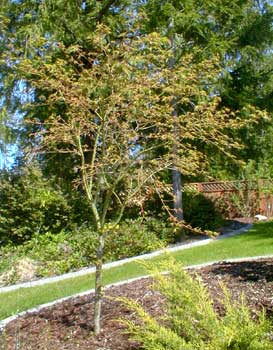
Greenleaf
Japanese
Maple
"Lo, the dawn was flowering
Through the maple trees!
Oh, & you were showering
Kisses over me!"
-John Gneisenau Neihardt
(1881-1973)
(1881-1973)
Greenleaf Japanese maples (Acer palmatum var palmatum) are usually field-grown from seeds & are marketed without specific cultivar name.
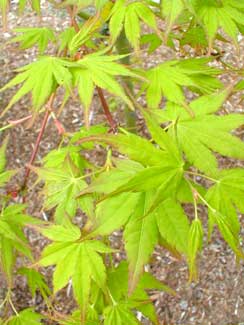 They're as close to the wild green Japanese maple as can be had for American gardens, with upright form, no weeping branches, & palmate leaves.
They're as close to the wild green Japanese maple as can be had for American gardens, with upright form, no weeping branches, & palmate leaves.Although less colorful in spring & summer than A. palmatum atropurpureum & sundry red-leaf forms, the standard green nevertheless has great autumn colors, from yellows to purples & bright reds.
Whether a given tree leans more to the yellows or more to the reds is quite variable from specimen to specimen. A greenleaf Japanese maple is ideally selected in autumn since there's no question what it will be like the rest of the year, but quality of autumn colors can vary greatly.
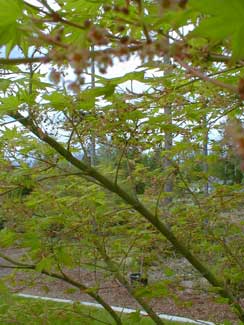 This young specimen at the estate of a friend for whom I've done some landscaping is shown in its Spring cloak in three photos snapped consecutively early to late April. The fourth & fifth photos from mid-October reveal superior autumn russets with highlights of red-gold for this tree.
This young specimen at the estate of a friend for whom I've done some landscaping is shown in its Spring cloak in three photos snapped consecutively early to late April. The fourth & fifth photos from mid-October reveal superior autumn russets with highlights of red-gold for this tree. Most Japanese maple cultivars are slow-growing to about twenty feet, with equally broad generally rounded crown. The standard green can be comparatively swift in its growth, though unpredictability of the origin of the seedstock makes somewhat speedier growth hard to count on.
In general it is as vigorous as 'Atropurpureum' which is likewise a wild form that can be grown from seed rather than as a grafted or clonal cultivar.
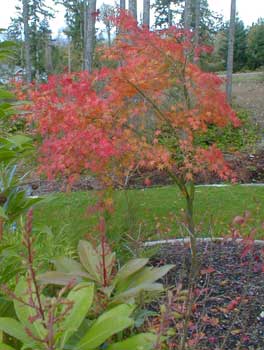 Botanically named in 1775, western gardeners first became aware of A. palmatum in 1784 with Philipp Franz Balthasar von Seibold's book Flora Japonica (see the second half of the article on Japanese Dwarf Cypress for a discussion of von Seibold's contributions to horticulture).
Botanically named in 1775, western gardeners first became aware of A. palmatum in 1784 with Philipp Franz Balthasar von Seibold's book Flora Japonica (see the second half of the article on Japanese Dwarf Cypress for a discussion of von Seibold's contributions to horticulture).The first book in English devoted to the topic of Japanese maples was written much more recently than seems plausible, in 1987, by the late J. D. Vertrees, the leading authority on the topic in his lifetime. The book was revised & updated by Peter Gregory for republication in 2001 & remains the key book on the topic.
Those of us who grew up in or around Seattle & near the University of Washington's Arboretum with its very old collection of Japanese maples often don't realize how recent the widespread craze for these trees really is. The greater explosion of interest only began in the early 1990s.
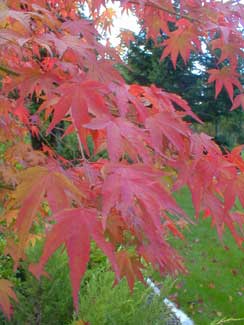 Small red spring flowers precede the leaves & can momentarily give a red glow to the leafless tree. The flowers are much too little to make a major show, but are gorgeous up close. They develop rapidly into tiny seeds beginning with a pink glow & turning green as they mature in size, then brown when ripe by the following year's leaf-fall.
Small red spring flowers precede the leaves & can momentarily give a red glow to the leafless tree. The flowers are much too little to make a major show, but are gorgeous up close. They develop rapidly into tiny seeds beginning with a pink glow & turning green as they mature in size, then brown when ripe by the following year's leaf-fall.This particular Greenleaf Japanese Maple grows on a slope overlooking pieris shrubs, & is in turn overlooked by a big Western Cedar which provides the maple with the bright shade it likes best.
In the 11th Century, a Zen priest wandered throughout the Korankei valley & all along the Tomoe River, planting green maples while reciting sutras for peace & good fortune, which maples symbolize. During the "koyo" or autumn leaf season, the hills & gorge & village of Korankei appear to be on fire with the "Peace Maples" all bright red.
For their sacredness, hundreds of cultivars have been developed on mountainsides surrounding temples throughout Japan, & autumn viewing-parties & maple festivals are signal events.
Autumn maples also represent the graceful passage of time, of beauty fading into old age, being very frequently a motif on furisode or classical wedding kimonos to remind even a young bride in her happiest hour of "the sadness of things," a Buddhist expression of life's impermanence.
The leaves are so colorful toward year's end that they are regarded as the flowers of Fall. Such leaves are even the unofficial "flower" of Hiroshima, their explosive fieriness a reminder of the bomb, but also of the peace that followed.